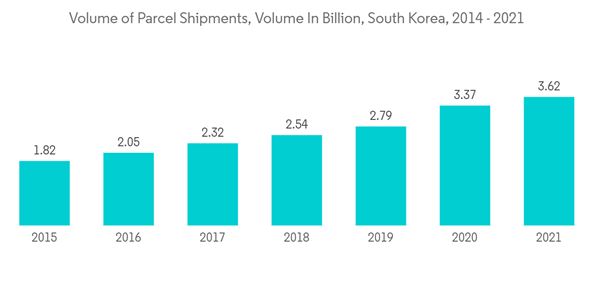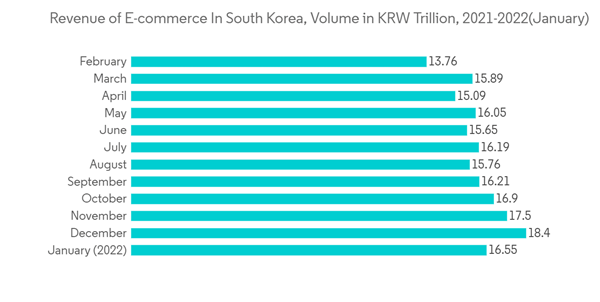The retail industry has made a concerted effort to improve the same-day delivery system. As a result of COVID-19, non-face-to-face consumption has become more prevalent, an immediate delivery system has been created, and the 'omnichannel is being consolidated. Food and beverage companies are enhancing consumer convenience by offering same-day delivery services when placing orders.
In addition, courier services grew in popularity as the outbreak spread across Korea. After the pandemic, the average number of times people utilized a courier service increased from 6.22 to 9.74 per month. Korea's parcel volume is expected to reach 5.6 billion boxes in the second half of 2023, more than double that of 2019. When split down by age, individuals in their 20s used delivery services 9.5 times per month, up from 5.36 times before the pandemic, a 77% increase and the largest increase of all age groups. However, the online shopping transaction value marked KRW 16.5438 trillion in January 2022, rising by 11.5% from January 2021. The mobile shopping transaction value marked KRW 12.4978 trillion in January 2022, rising by 17.5% from January 2021.
South Korea International CEP Market Trends
Increase in Volume of Parcel Shipments in South Korea
Parcel shipments in South Korea witnessed significant growth in 2021. The total parcel delivery volume accounted for 3.62 billion, which increased by 7.59% compared to 2020 (3.37 billion). Furthermore, the rate of freight volume continued to increase from the previous year to 9.7% in 2019, 20.9% in 2020, and 7.59% in 2021.In 2020, parcel shipments in Seoul increased by 26.9% over the previous year, as a rising number of individuals preferred ordering groceries and other daily essentials online in the wake of COVID-19. According to an industry assessment, due to the impact of COVID-19, parcel deliveries of food, household supplies, and health products in the capital increased by roughly 50% in 2020. In contrast, the survey found that maternity and newborn care products had lower delivery shipments, indicating that the country's birth rate is declining.
In 2020, parcel deliveries for household and health supplies, such as hand sanitizers and masks, increased by 52% Y-o-Y, while online meal delivery increased by 46%. Parcel shipping of furniture and interior goods increased by 39% compared with 31% for books and music albums, 29% for sports and leisure goods, and 16% for clothing. Notably, the volume of parcel delivery demand for DIY goods and supplies spiked in March, August, and December, when social distancing rules were strengthened. CJ Logistics reported a 21% rise in the first-half operating profit, and Hanjin Transportation posted a 35% increase. These companies represent about 64% of the delivery market.
Growth in Fashion Sector Driving the Market
South Korea saw a rapid growth in the B2C apparel e-commerce market in 2020 than between 2018 and 2019. Online retail sales in the country's fashion sector (including clothing, footwear, accessories, and cosmetics) increased Y-o-Y between January 2022 and January 2021 by more than 2.5%.So far, in 2022, apparel and personal care sales have witnessed robust growth, at more than USD 36 billion and USD 16 billion, respectively. In addition, the Y-o-Y growth rates of the apparel and personal care sectors were 25% and 10%, respectively, compared to 2021. However, more than 38 million people purchased consumer goods via e-commerce platforms.
Moreover, sales in the fashion category are driven by increasing internet users in the country. In January 2022, the country had more than 50.3 million internet users, with more than 98% of the total population using internet services. Also, South Korean citizens’ total annual spending on online consumer goods purchases accounted for more than USD 110 billion, with an annual growth rate of 15%. In January 2022, total online sales accounted for more than KRW 16.54 trillion, in which the fashion category contributed more than 22% share of sales.
South Korea International CEP Market Competitive Analysis
The South Korean international CEP market is fragmented, with a mix of global and local players, making it highly competitive. Some of the strong players include CJ Logistics, Aramex, DB Schenker, Korea Post, and DHL. Many organizations began investing in extending their logistics operations to take advantage of the prospect of rapid expansion in the CEP industry provided by the need for same-day delivery. The concept of the final mile is encouraging businesses to focus on mergers and collaborations to expand globally and improve their overall service quality.Additional Benefits:
- The market estimate (ME) sheet in Excel format
- 3 months of analyst support
This product will be delivered within 2 business days.
Table of Contents
Companies Mentioned (Partial List)
A selection of companies mentioned in this report includes, but is not limited to:
- CJ Logistics
- Aramex
- DB Schenker
- Korea Post
- DHL
- Agility
- KERRY LOGISTICS NETWORK LIMITED
- DSV
- HANJIN TRANSPORTATION CO. LTD
- LOTTE GLOBAL LOGISTICS CO. LTD
- Linex Solutions
- C.H. Robinson Worldwide Inc.
- SEKO Logistics
- Nippon Express
- Guangdong SF
- FedEx










